 LUNAR’clips
2004
Volume 11, Number 3
LUNAR’clips
2004
Volume 11, Number 3
 LUNAR’clips
2004
Volume 11, Number 3
LUNAR’clips
2004
Volume 11, Number 3
Livermore Unit of the National Association of Rocketry May/June 2004
Copyright © 2004 by LUNAR, All rights reserved.
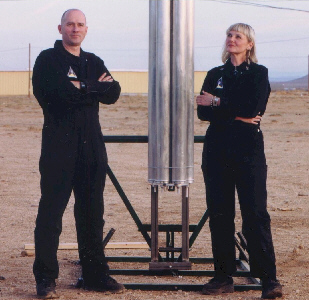 |
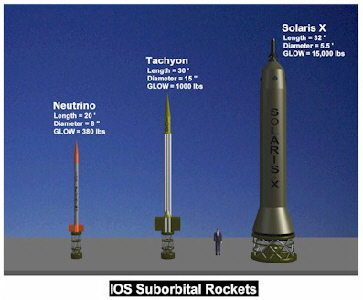 |
Interorbital Systems (IOS) was founded in 1996 and is based in Mojave, California, and their team leaders are Roderick and Randa Milliron. Their entry in the X-Prize is the Solaris X rocket plane, which is the orbiter stage of the Neptune-Solaris Orbital Spaceliner they are developing, which is intended to be a two-stage manned reusable orbital launcher. Solaris X is a liquid-propelled, vertical take-off/horizontal landing vehicle capable of sub-orbital flights to 100 miles (161 km). Flight duration time is 16 minutes, and the turn-around time between flights is expected to be seven days.
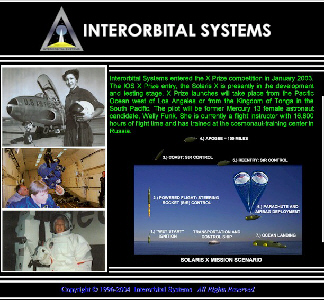 |
 |
Wally Funk, one of the original "Mercury 13" female astronaut trainees in the early 1960s, will pilot the Solaris X in IOS' ANSARI X-Prize launch attempts. She is currently a flight-instructor with 16,800 hours of flight time.
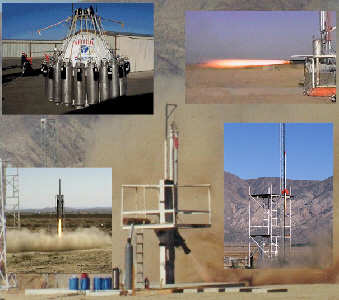 |
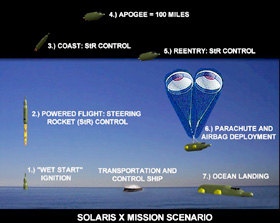 |
Interorbital Systems recently announced its intention to launch the first teenager into space. Justin Houchin, a 17-year old high school graduate, robotics enthusiast, and Eagle Scout candidate, is seeking sponsorship to complete the purchase of a ticket to ride aboard this rocket.
Their Website is at www.interorbital.com
![]()
Micro-Space is based in Denver, Colorado, and the team is led by Richard Speck. Their entry in the X-Prize is called Crusader X, which uses a lightweight core frame with seats and windshield resembling a bobsled or undersea sled. Propulsion modules are strapped onto the sides which are retained for the entire flight. Life support equipment is worn by the crew. The core holds the attitude control jets, tiny flight controller, and parachute packages. The craft uses pressure fed liquid rocket engines for its vertical takeoff, and uses a parachute recovery.

To quote them: "Many of the X PRIZE entries are elegant concepts: Micro-Space's is not. Ours is an assemblage rather that a unique design, since our only hope of rapid success lies in using what we have already developed. … The Micro-Space suborbital vehicle is assembled from the modular propulsion units which are used in our other designs. It uses a cockpit core much like a bobsled into which three pressure suited men can squeeze. Various configurations of propulsion strap-ons are possible. To have a shot at winning the X PRIZE it will be necessary to use a large cluster of the 4 inch diameter propulsion modules we are now flight testing. Later flights will be able to use a small number of larger diameter modules as illustrated. … Complexity troubles many, and our assembly looks complex. Yet using a large number of motor units can greatly increase reliability. In our designs, the motors have no moving parts, and all are brought up to full thrust while the vehicle is still locked into its launch tower. The propulsion modules are more like big propane torches than "engines". Only after stabilization of all the propulsion units is there a commitment to flight, then the lock down clamps are blown, and the flight begins.
Their Website is at www.micro-space.com
These two teams complete our review of the X-Prize entrants, and it looks as though the timing is perfect. There are around five teams preparing for launch attempts, so there should be something more to write about for the next 'Clips.
We wish all the entrants well with their attempts at reaching space and returning safely.
All content is the responsibility of LUNAR.
If you have comments or suggestions regarding these web pages,
please contact the 
Copyright © 1992 - 2025 LUNAR